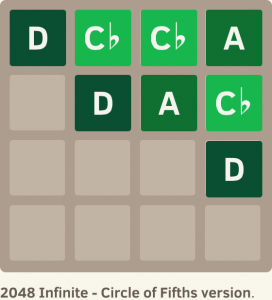 The Circle of Fifths can be considered a tone row. Cool, huh? One of the defining concepts of the tonal system when written in a score turns out to be atonal. It’s an oxymoron, really. A tonal tone row. Atonal tonality. Consonant dissonance. A never-ending resolution. The beauty of the paradox is unending.
The Circle of Fifths can be considered a tone row. Cool, huh? One of the defining concepts of the tonal system when written in a score turns out to be atonal. It’s an oxymoron, really. A tonal tone row. Atonal tonality. Consonant dissonance. A never-ending resolution. The beauty of the paradox is unending.
Two Sides of the Tonal Tone Row Spectrum
The amount of tonality you hear really depends on the rate at which you hear the notes and how many are played at a time. To start out the audio examples, listen to a clear presentation of the circle of fifths as a tone row:
Now, before anyone decides to be a Smart Aleck, yes I know that when you invert a fifth it turns into a fourth and that my example has fourths. But since this is atonal music, we are dealing in pitch classes, not in intervals. 🙂 I win.
Since the first example is played rapidly, it is perceived as sounding random. Yet at the same time it is symmetrical; perfectly ordered and balanced. That’s the touch of tonality leaking into the sound. We just can’t fully get away from it!
Let’s try a bunch of notes together without using orchestration to change how it’s heard.
Pretty much the same effect. Now lets try changing the orchestration and the number of notes we hear at one time. We can trick the ear into hearing tonality.
We were certainly able to drive that F to resolve to the E. Not very tonal, but we were able to get enough emphasis on a single pitch the make some of the original serialists not approve (Webern, anyway). Let’s see if we can sound like Berg by using rhythm to reach into tonality.
Still Serialism, but we are certainly getting dangerously close to tonality! Now let’s do a little repetition and break from the serial idea entirely.
I could listen to stuff like that all day! All 12 pitches were used many times using the contour of the circle of fifths, but we were definitely in C. The reason it sounds so different is that the pitches are separated into musical ideas over time instead of just thrown at the ear all at once. It’s also why we can’t call it serialism, but it’s still the circle of fifths! And now for a little hop to the total opposite side of the style spectrum.
And that’s how to serialize tonality. I hope you enjoyed my little tone row based compositions!
To hear the circle of fifths paradox over a very long period of time, try 2048 Infinite – The Circle of Fifths. It’s as fun as it sounds.


